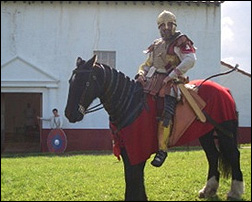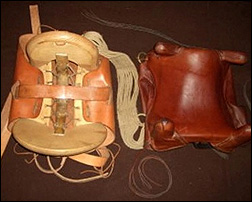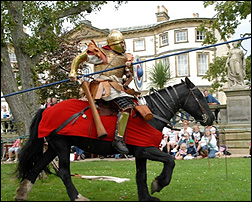


Left. The steppe saddle. Note the lack of padding, detachable flaps to protect the leg, and the woven girth strap directly attached to the robust frame.
Right. A wooden framed four-horned saddle with Carlisle-style saddle cover with side flaps. The front of each saddle is towards the top of the picture.

The typical Roman horse of around 14 hands, unshod, strong, with a broad back, at the canter. A strung recurve bow is carried in a case. The rider is holding a contos in both hands, using weight distribution and legs to control the horse.

The kontos, in this case a 4m long slender lance in two halves joined by an iron collar. An iron ferrule is attached to the butt. The horse barding is in part based on drawings of the destroyed Column of Theodosius copied by Franco Giovanni Battista il Semolei in the 16th century, now in the musée du Louvre. Note the manica, rigid scale cuirass, and leather thigh guards – a speculative assemblage.

Horse archery at the canter against a static folkon formation at close range. The rider’s body is held within a subarmalis and a cuirass of locked scale. The horse is balanced with all four hooves off the ground. Note the bucket of plumbata carried from the front right of the saddle.
